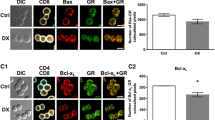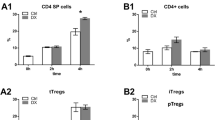Abstract
In order to characterise the mechanism of cytotoxicity of the immunotoxic organotin compound bis(tri-n-butyltin)oxide (TBTO) to lymphoid cells, isolated thymocytes from immature rats were exposed to TBTO (0.1–5 μM) for up to 6 h. At lower TBTO concentrations (0.1 and 1 μM) vital staining showed that only marginal loss of viability occured, although morphological studies demonstrated increased numbers of cells with abnormal features indicative of programmed cell death (apoptosis). These changes included nuclear chromatin condensation (which was associated with increased DNA fragmentation), cytoplasmic contraction and formation of membrane bound apoptotic bodies. When visualised by agarose gel electrophoresis, genomic DNA appeared as a series of fragments with a repeat multiple of 180–200 base pairs. Comparable morphological changes and cleavage of DNA into oligonucleosomal fragments were evident in thymocytes incubated with 10 μM methyl prednisolone hemisuccinate (MPS); a glucocorticoid hormone known to induce programmed cell death in thymocytes. Marked cytotoxicity associated with degenerative changes indicative of necrosis was observed in thymocytes incubated with 5 μM TBTO. These findings indicate that, at levels which are not overtly cytotoxic, TBTO is capable of inducing programmed cell death in rat thymocytes. This suggest a possible mechanism for the T-cell immunodeficiency previously reported for TBTO in vivo.
Similar content being viewed by others
Abbreviations
- TBTO:
-
bis(tri-n-butyltin)oxide
- HEPES:
-
N-[2-hydroxy-ethyl]piperazine-N′-[2-ethanesulphonic acid]
- MPS:
-
methylprednisolone sodium hemisuccinate
References
Boyer IJ (1989) Toxicity of dibutyl, tributyl and other organotins to humans and to experimental animals. Toxicology 55: 253–298
Burton K (1956) A study of the conditions and mechanism of the diphenylamine reaction for the colorimetric estimation of deoxyribonucleic acid. Biochem J 62: 315–323
Cohen JJ, Duke RC (1984) Glucocorticoid activation of a calcium-dependent endonuclease in thymocyte nuclei leads to cell death. J Immunol 132: 38–42
Compton MM, Cidlowski JA (1986) Rapid in vivo effects of glucocorticoids on the integrity of rat lymphocyte genomic deoxyribonucleic acid. Endocrinology 118: 38–45
Duvall E, Wyllie AH (1986) Death and the cell. Immunology Today 7: 115–119
Krajnc EI, Wester PW, Loeber JG, van Leeuwen FXR, Vos JG, Vaessen HAMG, van der Heijden CA (1984) Toxicity of bis(tri-n-butyltin)oxide in the rat I. Short-term effects on general parameters and on the endocrine and lymphoid systems. Toxicol Appl Pharmacol 75: 363–386
McConkey DJ, Hartzell P, Duddy SK, Hakansson H, Orrenius S (1988a) 2,3,7,8-Tetrachlorodibenzo-p-dioxin kills immature thymocytes by Ca2+-mediated endonuclease activation. Science 242: 256–259
McConkey DJ, Hartzell P, Nicotera P, Wyllie AH, Orrenius S (1988b) Stimulation of endogenous endonuclease activity in hepatocytes exposed to oxidative stress. Toxicol Lett 42: 123–130
McConkey DJ, Hartzell P, Nicotera P, Orrenius S (1989) Calcium-activated DNA fragmentation kills immature thymocytes. FASEB 3: 1843–1849
Schrantz J (1990) TBT marine paint under EPA scrutiny. Industrial Finishing 66: 58–61
Searle J, Kerr JFR, Bishop CJ (1982) Necrosis and apoptosis: distinct modes of cell death with fundamentally different significance. Pathol Annu 17: 229–259
Seinen W, Penninks AH (1979) Immune suppression as a consequence of a selective cytotoxic activity of certain organometallic compounds on thymus and thymus-dependent lymphocytes. Ann N Y Acad Sci 320: 499–517
Smith CA, Williams GT, Kingston R, Jenkinson EJ, Owen JJT (1989) Antibodies to CD3/T-cell receptor immune complex induce death by apoptosis in immature T cells in thymic cultures. Nature 377: 181–184
Snoeij NJ, van Iersel AAJ, Penninks AH, Seinen W (1986a) Triorganotin-induced cytotoxicity to rat thymus, bone marrow and red blood cells as determined by several in vitro assays. Toxicology 39: 71–83
Snoeij NJ, Punt PM, Penninks AH, Seinen W (1986b) Effects of tri-n-butyltin chloride on energy metabolism, macromolecular synthesis, precursor uptake and cyclic AMP production in isolated rat thymocytes. Biochim Biophys Acta 852: 234–243
Snoeij NJ, Penninks AH, Seinen W (1988) Dibutyl and tributyltin compounds induce thymus atrophy in rats due to a selective action on thymic lymphoblasts. Int J Immunopharmacol 10: 891–899
Thomas N, Edwards JL, Bell PA (1983) Studies on the mechanism of glucocorticoid-induced pyknosis in isolated rat thymocytes. J Steroid Biochem 18: 519–524
Van der Kerk GJM (1976) Organotin chemistry: past, present and future. In: Zuckermann JJ (ed) Organotin compounds: new chemistry and applications. American Chemical Society, Washington, pp 1–25
Vos JG, de Klerk A, Krajnc EI, Kruizinga W, van Ommen B, Rozing J (1984) Toxicity of bis(tri-n-butyltin)oxide in the rat II. Suppression of thymus-dependent immune responses and of parameters of non-specific resistance after short-term exposure. Toxicol Appl Pharmacol 75: 387–408
Vos JG, Krajnc EI, Wester PW (1985) Immunotoxicity of bis(tri-n-butyl-tin)oxide. In: Dean JH, Luster MI, Munson AE, Amos H (eds) Immunotoxicity and immunopharmacology. Raven Press, New York, pp 327–340
Wyllie AH (1980) Glucocorticoid-induced thymocyte apoptosis is associated with endogenous endonuclease activation. Nature 284: 555–556
Wyllie AH (1986) What is apoptosis? Histopathology 10: 995–998
Wyllie AH (1987) Apoptosis: cell death under homeostatic control. Arch Toxicol Suppl 11: 3–10
Wyllie AH, Kerr JFR, Currie AR (1980) Cell death: the significance of apoptosis. Int Rev Cytol 68: 251–306
Wyllie AH, Morris RG, Smith AL, Dunlop D (1984) Chromatin cleavage in apoptosis: association with condensed chromatin morphology and dependence on macromolecular synthesis. J Pathol 142: 67–77
Yamada T, Ohyama H, Kinjo Y, Watanabe M (1981) Evidence for the internucleosomal breakage of chromatin in rat thymocytes irradiated in vitro. Radiat Res 85: 544–553
Author information
Authors and Affiliations
Rights and permissions
About this article
Cite this article
Raffray, M., Cohen, G.M. Bis(tri-n-butyltin)oxide induces programmed cell death (apoptosis) in immature rat thymocytes. Arch Toxicol 65, 135–139 (1991). https://doi.org/10.1007/BF02034940
Received:
Accepted:
Issue Date:
DOI: https://doi.org/10.1007/BF02034940




